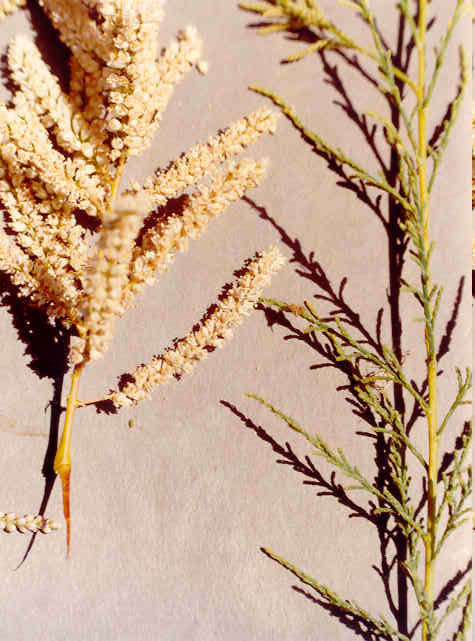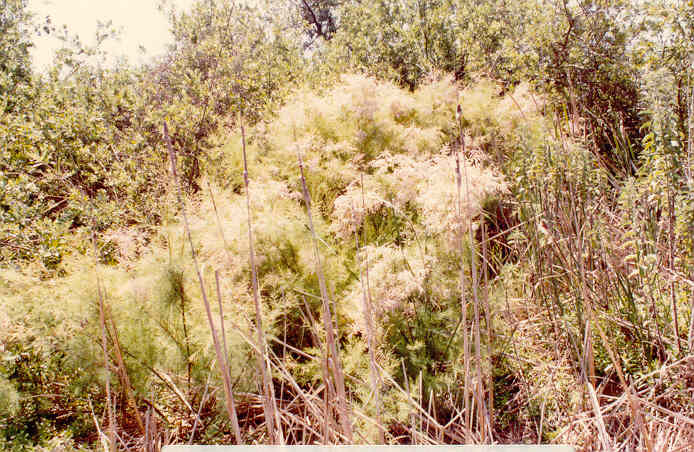
Tamarix chinensis Lour.
 |
Tamarix chinensis Lour.
Tamaricaceae (Tamarisk Family)ChinaChinese TamariskSalt CedarTamarix |
May Photo
Plant Characteristics:
Shrub or small tree to 10 m., with slender spreading or drooping
branches; lvs. 1.5-3 mm. lanceolate, keeled, bluish-green; fls. pink, in racemes
1.5-7 cm. long forming lose usually nodding panicles, in summer; petals
persistent; sepals 0.5-1.5 mm., ovate, acute; petals 1.5-2 mm., oblong to
elliptic; stamens deeply inserted between the lobes of the disk; bracts
subulate, longer than pedicels; disk deeply 10 lobed.
Habitat:
Escape from cultivation. Frequent
on deserts; non saline areas. Bloom
period not listed in Bailey or Munz, it seems to be from May to July locally..
Name:
Tamarix, the ancient Latin name.
(Bailey 678). Tamaris, river in Spain. (Munz, Flora So. Calif. 844).
Chinensis, indicates that the first species identified were from China.
(Dale 13).
General:
Uncommon in the study area with most of the plants located in the Big
Canyon area. Photographed in
big Canyon. In 2000 a plant was
found at 23rd St. and on the bluff at the end of Back Bay Dr just
before it ends at Eastbluff Dr. (my comments).
In the arid west, where water is life, the tamarisk tree has made few
friends. Tamarisk is a virulent
pest in desert riparian areas because it aggressively displaces native trees and
shrubs...and it is a poor source of food and shelter for desert wildlife.
Sometimes called salt cedar, tamarisk is not native to the North American
continent. The nursery trade
brought several deciduous species of the genus Tamarix to this country
from Eurasia in the 1850's for use as an ornamental, as a windbreak, and as a
means of erosion control. This
slight, feathery tree or large shrub with its stunning sprays of pink to almost
white flowers was extolled for its hardiness in certain climates. Those claims weren't exaggerated. Virtually unknown in the wild at the turn of the century, by
1920 tamarisk had spread, on its own, to some 10,000 acres of streamside and
floodplain. Today it covers well
over a million acres in fifteen states and is still spreading.
In California it lays claim to roughly 16,000 acres.
The tamarisk has a bag of survival tricks unequaled by any of the West's
native vegetation. One single plant
can produce hundreds of thousands of pollen-sized seeds that are easily
scattered by wind and water. They
also cling to fur and feathers. Too
small to be eaten by birds and rodents, the seeds germinate in a wide variety of
conditions and sprout like lawn grass. Tamarisk
does not succumb to insect pests in this country; it can't be killed by foliar
applications of herbicide; and its scale-like leaves are unpalatable to grazing
animals. Moreover, removing the
trees by cutting can result in regrowth of more than four feet in month's time.
The tamarisk is a phreatophyte, a plant that survives in dry climates by
extending its roots all the way down to the water table.
With this virtually unlimited supply of moisture, the phreatophytes have
never developed the water-conserving adaptations of other desert vegetation.
But the exotic tamarisk uses far more water than do the native
phreatophytes-more than any other native phreatophyte.
One large tree can absorb 200 gallons of water a day.
Given a conservative estimate of a million acres of tamarisk, this plant species
consumes nearly twice as much water as do the major cities of southern
California. Through glands in its
leaves, tamarisk secretes salt, which falls to the ground in the form of
crystals and forms an environment that few native plants can tolerate.
Because of invading salt cedar, many of the desert pools at Death Valley
National Monument had disappeared. After
experimenting with numerous eradication techniques, the U.S. Park Service found
the best method: crews using hand
or chain saws cut the plants down to ground level and then applied systemic
herbicide directly to the stumps to inhibit resprouting.
Although labor intensive, this is the only technique currently known to
be suitable for use in ecologically sensitive areas.
The pools in Death Valley are back.
Conservationists face a double challenge, First, how do they eradicate
the trees? Second, how do they
ensure the return of native flora? Working
with the Bureau of Reclamation, an area on the lower Colorado River has been
restored. Here an impenetrable
thicket of tamarisk was bulldozed, and the roots were cut below the soil surface
using a massive root ripper pulled behind a bulldozer. The site was then carefully planted with appropriate native
vegetation. This project was most
successful, but the price tag was high: more than $2,000 per acre, not including
the cost of clearing. (Originally
printed in the Nature Conservancy News, October-November, 1986).
The above was copied from an article by Johnson, Stephen. "Can
Tamarisk be Controlled?" Fremontia, A Journal of the Native Plant
Society. Spring 1987, P. 19,20.
Since the mid-1980’s federal researchers have explored using Chinese
leaf beetles that feed on tamarisk to get the invasion under control. To insure that they won’t devour other plants, scientists
are cautiously testing the beetles. The
beetles, about the size of a fingernail, have been shown to attack tamarisk
without spreading to other plants. Hettena, Seth The Associated Press
“West’s Water Hazard” Orange County Register 15 June 2003. morning
edition, News 16. Researchers at the University of Nevada, Reno have been
experimenting with the Chinese leave-eating beetle Diorhabda elongata to
determine how effective it is in killing Salt Cedar.
Tamarisk, as it is also called, has been blamed for more than $200
million in environmental damage across the West. No author, no title
USA TODAY 3 August, 2004 6A.
About 75 species of deciduous and sometimes evergreen
shrubs or trees from the Medit. region to E. Indies and Japan. (Bailey 678).
Text Ref:
Bailey 679; Hickman, Ed. 1080; Munz, Flora So. Calif. 844, Roberts
40.
Photo Ref:
April 2 84 # 17,18; May 2 84 # 2,3,4.
Identity: by F. Roberts.
First Found: April 1984.
Computer Ref: Plant Data 281
Have plant specimen.
Last edit 8/6/04.
 |
May Photo